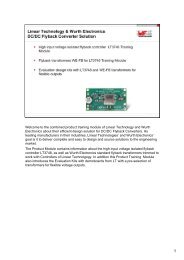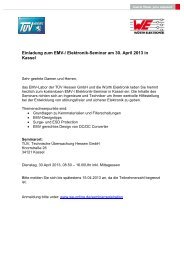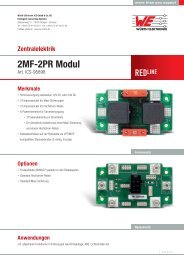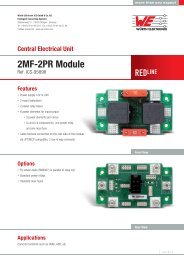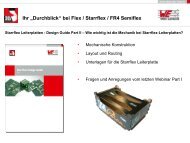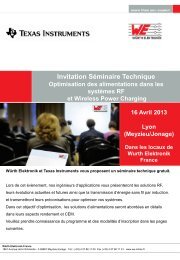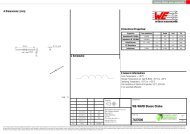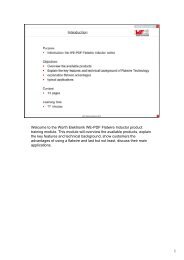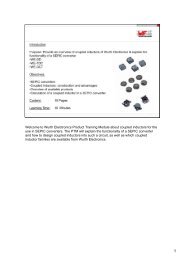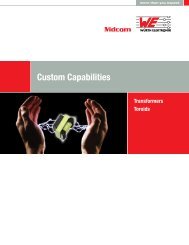Welcome to Wurth Electronics' product training module. This module ...
Welcome to Wurth Electronics' product training module. This module ...
Welcome to Wurth Electronics' product training module. This module ...
Create successful ePaper yourself
Turn your PDF publications into a flip-book with our unique Google optimized e-Paper software.
<strong>Welcome</strong> <strong>to</strong> <strong>Wurth</strong> Electronics‘ <strong>product</strong> <strong>training</strong> <strong>module</strong>.<br />
<strong>This</strong> <strong>module</strong> overviews the available magnetics solutions for various LED<br />
lighting applications, their key features, and their various applications.<br />
1
Before going in<strong>to</strong> detail about the individual LED drivers, <strong>Wurth</strong> Electronics<br />
would like <strong>to</strong> point out the benefits of using their transformers in LED<br />
applications. From the use of standard components <strong>to</strong> the cus<strong>to</strong>m build<br />
transformers for reference designs, <strong>Wurth</strong> Electronics puts a large focus on their<br />
work with the industry‘s leading IC manufacturers. The advantages of this focus<br />
is the excellent availability of the materials, which leads <strong>to</strong> a short lead time for<br />
pro<strong>to</strong>typing and <strong>product</strong>ion. <strong>This</strong>, and over 30 years of experience in designing<br />
and manufacturing magnetics, leads <strong>to</strong> a high manufacturability of components<br />
and offers you, as a cus<strong>to</strong>mer, the most „economical“ transformer solution. <strong>Wurth</strong><br />
Electronics Midcom‘s transformers are designed <strong>to</strong> an optimal performance in<br />
your offline LED driver application by offering an optimum built in EMI<br />
protection. <strong>Wurth</strong> Electronics is offering transformers from the original reference<br />
design of the leading manufacturers of LED Driver ICs at digikey.com.<br />
2
In order <strong>to</strong> determine the optimum magnetics solution for any LED power supply<br />
application, a clear definition of the following requirements is imperative:<br />
• Input Voltages<br />
• Output Voltages and Currents<br />
• Isolation and Safety Requirements<br />
• Dimming Requirements<br />
• Operating Temperature Range<br />
• EMI Requirements<br />
3
<strong>Wurth</strong> Electronics continuously engages in the forefront of LED lighting<br />
development by working closely with IC manufacturers such as Cypress,<br />
Infineon, National Semiconduc<strong>to</strong>r, NXP, ON Semiconduc<strong>to</strong>r, Texas Instruments,<br />
and many others.<br />
As LEDs behave like constant voltage loads with low equivalent series<br />
resistance, a switch-mode power supply with constant current output is the<br />
generally preferred “driving” method for LED lighting. <strong>This</strong> is due <strong>to</strong> its<br />
compact design, economy, and efficiency levels up <strong>to</strong> 90%. These high<br />
efficiency levels are achieved with minimal cost by employing a flyback or<br />
similar <strong>to</strong>pology, which also features the necessary electrical isolation <strong>to</strong> meet the<br />
safety requirements in different regions. The following are examples of the<br />
implementation of <strong>Wurth</strong> Electronic Midcom’s transformer <strong>product</strong>s in different<br />
LED lighting applications.<br />
4
In Cypress’s CY8CLEDAC02 retrofit solution for incandescent bulbs, <strong>Wurth</strong>’s<br />
750311992 flyback transformers offer a highly compact design, while<br />
maintaining high efficiency and compliance <strong>to</strong> UL 1310 specification. The<br />
transformers are also designed for noise-free operation, especially when utilizing<br />
the controller’s dimming functions.<br />
5
For Infineon’s BCR450 street and indoor lighting solution, <strong>Wurth</strong>’s 750845240<br />
flyback transformer offers low dis<strong>to</strong>rtion and high efficiency performance. It<br />
also has a rated isolation of 4500 VAC.<br />
6
NXP’s 12-22 Watt Dimmable LED driver replaces lamps with a power rating up<br />
<strong>to</strong> 150 Watts. For this solution, <strong>Wurth</strong> Electronics Midcom offers the 750340505<br />
flyback transformer, which features a universal input voltage capability of 85<br />
Volts <strong>to</strong> 276 Volts; it also features a low-profile and high-efficiency design.<br />
7
ON Semiconduc<strong>to</strong>r’s NCL30001 solution for street and low bay LED lighting<br />
uses <strong>Wurth</strong>’s 750311269 flyback transformers. The 75-Watt output capability of<br />
the transformer allows for a high LED illumination for outdoor applications. The<br />
transformer enables the system <strong>to</strong> have an efficiency up <strong>to</strong> 92%, a power fac<strong>to</strong>r of<br />
more than 0.9, and a universal input of 90 – 265 Vrms.<br />
8
National Semiconduc<strong>to</strong>r’s 8-Watt driver utilizes <strong>Wurth</strong>’s 750311553 flyback<br />
transformer. The transformer is designed <strong>to</strong> exceed a power fac<strong>to</strong>r correction of<br />
0.99 for line injection circuits. The transformer is also designed <strong>to</strong> have<br />
reinforced insulation as specified by IEC 61558-2-17.<br />
9
Texas Instruments’ low-cost TPS92210-PMP6001<br />
employs <strong>Wurth</strong>’s 750811146<br />
flyback transformer. The<br />
transformer has reinforced<br />
insulation per IEC 60950-1, while<br />
maintaining a relatively low PCB<br />
footprint. The transformer allows<br />
for a constant LED illumination<br />
function with a universal input of<br />
90-265 Vrms.<br />
10
The insulation and safety requirements can have a signifcant impact on the size,<br />
performance, cost, and reliability of the transformer. It is therefore critical <strong>to</strong><br />
select the correct governing standandard for the specific design, as well as the<br />
level of insulation that will be needed. In general, Functional Insulation is the<br />
least stringent type of insulation, in which there are no creepage and clearance<br />
requirements – the insulation strength is only verified by a simple hipot test.<br />
Basic and Reinforced Insulation are commonly used for offline input voltages<br />
(85-265 Vrms). The difference between the two is Reinforced Insulation holds a<br />
more stringent requirement as far as creepage and clearance distance are<br />
concerned. These distance requirements are specified within the guidelines of<br />
the applicable governing standard. These safety standards include UL8750,<br />
UL60950, UL1310, and EN61347-2-13.<br />
11
Electromagnetic Interference (EMI) or unwanted noise, is a by<strong>product</strong> of most<br />
high-frequency switching devices, such as the drivers needed <strong>to</strong> operate LED<br />
lamps. Noise can be generated by both radiated and conducted emissions.<br />
For radiated noise interference, the solution is <strong>to</strong> shield certain components, or<br />
the entire circuit. Shielding the device blocks the unwanted signals, which are<br />
usually over 30MHz. The shielding is usually performed by copper shields <strong>to</strong><br />
divert, or ferrite shields <strong>to</strong> absorb, the unwanted signals.<br />
For conducted noise, the problem is from differential mode (symmetrical)<br />
interference or common mode (asymmetrical) interference, as seen in the circuit.<br />
Differential mode interference can be corrected by adding an inductive<br />
component on the Neutral and Line side of the input. On the other hand,<br />
common-mode interference can be corrected by using a common-mode choke –<br />
this choke has two windings on a common core such that each set of windings<br />
create an equal and in-phase magnetic fields; this causes high impedance <strong>to</strong> the<br />
common-mode signal.<br />
12
Recognizing the need for a single component solution that would effectively<br />
tackle both common-mode and differential-mode noise, <strong>Wurth</strong> Electronics<br />
developed the “Dual Coil Chokes Series,” which is a cost effective induc<strong>to</strong>r that<br />
would combine the advantages of both a common-mode choke and a differentialmode<br />
choke in<strong>to</strong> one device. By utilizing the nature of stray magnetic fields in a<br />
coupled winding, <strong>Wurth</strong> Electronics Midcom was able <strong>to</strong> create a common-mode<br />
choke that exhibited a high differential-mode inductance as well.
Similar <strong>to</strong> the “Dual Coil Series,” the WE-TFC chokes also combine the<br />
characteristics of both the common-mode and differential-mode chokes in<strong>to</strong> one<br />
package, but with different attenuation levels across the frequency range. The<br />
WE-TFC chokes also utilize the stray nature of magnetic fields in a coupled<br />
winding <strong>to</strong> maximize differential-attenuation capabilities.<br />
14
In summary, <strong>Wurth</strong> Electronics offers a full magnetics solution for your LED<br />
Driver with supplying an efficient Offline Transformer in combination with the<br />
correct line filter for EMI noise suppression. All <strong>product</strong>s shown are conveniently<br />
available from s<strong>to</strong>ck at www.digikey.com<br />
15



